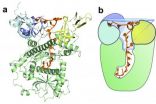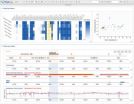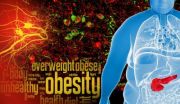(Press-News.org) Cold Spring Harbor, NY – Every once in a while, we are forced to sort that stack of papers on the kitchen counter. Interspersed between the expired coupons and dozens of takeout menus are important documents like your car insurance or electric bill. So it isn't an option to simply drop it all in the trash at once – you need to read through the messages to be sure that you don't lose vital information.
In the cell, proteins similarly read through messages to distinguish what needs to be saved and what needs to be discarded. But, here, the process takes on a much more important role. More than just clutter, messages that are marked for disposal can drastically alter the fate of a cell. In fact, stem cells use just such a mechanism to maintain their identity. So how does a protein detect the difference between two seemingly similar messages? Today, a team of Cold Spring Harbor Laboratory (CSHL) scientists, led by Professor and Howard Hughes Medical Institute Investigator Leemor Joshua-Tor, describe how the protein Dis3l2 uses numerous recognition sites to capture messages that are flagged for decay.
Dis3l2 is a molecular machine that helps to preserve the character of stem cells. It serves as the executioner of an elegant pathway that prevents stem cells from changing into other cell types. The protein does this by acting like a garbage disposal for messages in the cell, cutting them up until they no longer encode useful information. But Dis3l2 is necessarily highly specific. While it must degrade messages that would alter the fate of the stem cell, discarding the wrong message could have devastating consequences.
Therefore, Dis3l2 only targets specific messages that have been marked with a molecular flag, known as a "poly-U" chain. The enzyme ignores the majority of messages in the cell – those that go on to encode proteins and other critical messages – whose ends are decorated with a different type of chain, called "poly-A" tail.
The CSHL scientists set out to understand how Dis3l2 is able to read and distinguish between these two chains. In work published today in Nature, they used a type of molecular photography, known as X-ray crystallography, to observe the structure of Dis3l2 while bound to a poly-U chain. "We saw that the enzyme looks a lot like funnel, quite wide at the top and narrow at the base," says Joshua-Tor. "The poly-U chain inserts itself into the depths of this funnel while the rest of the bulky message can remain in the wide mouth at the top."
But how does the enzyme "read" the poly-U chain? Christopher Faehnle, PhD and Jack Walleshauser, lead authors on the paper, found that the interior of the funnel contains more than a dozen contacts that interact specifically with the poly-U chain. "Together, all of these points create a sticky web that holds the poly-U sequence deep within the enzyme," says Faehnle. "But other chains don't interact – they can slide right out. It has helped us understand how an enzyme can differentiate between two sequences in the cell."
More than that, the work provides insight into how a stem cell maintains its identity. "Misregulation of any step in this pathway leads to developmental disorders and cancer," says Joshua-Tor. "We now have a much better appreciation of the terminal step, a critical point of control."
INFORMATION:
This work was supported by Watson School of Biological Sciences, the Louis Morin Charitable Trust and the Robertson Research Fund of Cold Spring Harbor Laboratory.
"Mechanism of Dis3l2 substrate recognition in the Lin28–let-7 pathway" appears online in Nature on August 3, 2014. The authors are: Christopher Faehnle, Jack Walleshauser and Leemor Joshua-Tor. The paper can be obtained online at: http://dx.doi.org/10.1038/nature13553
About Cold Spring Harbor Laboratory
Founded in 1890, Cold Spring Harbor Laboratory (CSHL) has shaped contemporary biomedical research and education with programs in cancer, neuroscience, plant biology and quantitative biology. CSHL is ranked number one in the world by Thomson Reuters for the impact of its research in molecular biology and genetics. The Laboratory has been home to eight Nobel Prize winners. Today, CSHL's multidisciplinary scientific community is more than 600 researchers and technicians strong and its Meetings & Courses program hosts more than 12,000 scientists from around the world each year to its Long Island campus and its China center. For more information, visit http://www.cshl.edu.
Knowing what to keep and what to trash: How an enzyme distinguishes cellular messages
Molecular structure reveals how a protein reads RNAs to preserve stem cell identity
2014-08-03
ELSE PRESS RELEASES FROM THIS DATE:
Atlantic origin of recent Pacific trade wind, sea level and temperature trends
2014-08-03
An Australian–US team of climate researchers has solved a puzzle that has challenged scientists for over a decade. Climate models predict that the equatorial Pacific trades should weaken with increasing greenhouse gases. Yet, since the early 1990s, satellites and climate stations reveal a rapid and unprecedented strengthening of the Pacific trade winds, accelerating sea level rise in the western Pacific and impacting both Pacific and global climate.
"The answer to the puzzle is that recent rapid Atlantic Ocean warming has affected climate in the Pacific," say the scientists. ...
Self-assembling anti-cancer molecules created in minutes
2014-08-03
Researchers have developed a simple and versatile method for making artificial anti-cancer molecules that mimic the properties of one of the body's natural defence systems.
The chemists, led by Professor Peter Scott at the University of Warwick, UK, have been able to produce molecules that have a similar structure to peptides which are naturally produced in the body to fight cancer and infection.
Published in Nature Chemistry, the molecules produced in the research have proved effective against colon cancer cells in laboratory tests, in collaboration with Roger Phillips ...
Study finds new genetic risk markers in pancreatic cancer
2014-08-03
BOSTON –– A large DNA analysis of people with and without pancreatic cancer has identified several new genetic markers that signal increased risk of developing the highly lethal disease, report scientists from Dana-Farber Cancer Institute.
The markers are variations in the inherited DNA code at particular locations along chromosomes. Several of these variations in the DNA code were identified that influence an individual's risk for pancreatic cancer.
The discovery of these markers – along with four that were previously identified is important for several reasons, said ...
Rare developmental disorder linked to tumor-suppressing protein, Stanford researchers find
2014-08-03
CHARGE, which affects 1 in 10,000 babies, is an acronym whose letters stand for some of the more common symptoms of the condition: coloboma of the eye, heart defects, atresia of the choanae, retardation of growth and/or development, genital and/or urinary abnormalities, and ear abnormalities and deafness.
Originally, the researchers were examining the tumor-suppressive properties of the protein, called p53, not investigating developmental disorders. But when a mouse model developed a strange set of deficiencies, the researchers followed a trail of clues that led them ...
UMD researchers develop tool to better visualize, analyze human genomic data
2014-08-03
Scientists at the University of Maryland have developed a new, web-based tool that enables researchers to quickly and easily visualize and compare large amounts of genomic information resulting from high-throughput sequencing experiments. The free tool, called Epiviz, was described in a paper published online on August 3, 2014 in the journal Nature Methods.
Next-generation sequencing has revolutionized functional genomics. These techniques are key to understanding the molecular mechanisms underlying cell function in healthy and diseased individuals and the development ...
Making sense of scents
2014-08-03
For many animals, making sense of the clutter of sensory stimuli is often a matter or literal life or death.
Exactly how animals separate objects of interest, such as food sources or the scent of predators, from background information, however, remains largely unknown. Even the extent to which animals can make such distinctions, and how differences between scents might affect the process were largely a mystery – until now.
A new study, described in an August 3 paper in Nature Neuroscience, a team of researchers led by Venkatesh Murthy, Professor of Molecular and Cellular ...
Clues to curbing obesity found in neuronal 'sweet spot'
2014-08-02
New Haven, Conn. -- Preventing weight gain, obesity, and ultimately diabetes could be as simple as keeping a nuclear receptor from being activated in a small part of the brain, according to a new study by Yale School of Medicine researchers.
Published in the Aug. 1 issue of The Journal of Clinical Investigation (JCI), the study showed that when the researchers blocked the effects of the nuclear receptor PPARgamma in a small number of brain cells in mice, the animals ate less and became resistant to a high-fat diet.
“These animals ate fat and sugar, and did not gain ...
Pepper and halt: Spicy chemical may inhibit gut tumors
2014-08-02
Researchers at the University of California, San Diego School of Medicine report that dietary capsaicin – the active ingredient in chili peppers – produces chronic activation of a receptor on cells lining the intestines of mice, triggering a reaction that ultimately reduces the risk of colorectal tumors.
The findings are published in the August 1, 2014 issue of The Journal of Clinical Investigation.
The receptor or ion channel, called TRPV1, was originally discovered in sensory neurons, where it acts as a sentinel for heat, acidity and spicy chemicals in the environment. ...
Study reveals one reason brain tumors are more common in men
2014-08-02
New research at Washington University School of Medicine in St. Louis helps explain why brain tumors occur more often in males and frequently are more harmful than similar tumors in females. For example, glioblastomas, the most common malignant brain tumors, are diagnosed twice as often in males, who suffer greater cognitive impairments than females and do not survive as long.
The researchers found that retinoblastoma protein (RB), a protein known to reduce cancer risk, is significantly less active in male brain cells than in female brain cells.
The study appears Aug. ...
Understanding how neurons regulate metabolism in response to a high-fat diet
2014-08-02
The brain plays a central role in regulating appetite and whole-body metabolism. A protein known as PPARγ is important in the brain's control of food intake and body weight, but the identity of the neurons regulating this process has been unclear. A new study in the Journal of Clinical Investigation demonstrates that PPARγ activity in a type of neuron known as pro-opiomelanocortin (POMC) neurons is critical in mediating the response to high-fat diet. Sabrina Diano and colleagues at Yale University School of Medicine found that mice lacking PPARγ specifically ...
LAST 30 PRESS RELEASES:
Bluey’s dad offered professorial chair in archaeology at Griffith University
Beyond small data limitations: Transfer learning-enabled framework for predicting mechanical properties of aluminum matrix composites
Unveiling non-thermal catalytic origin of direct current-promoted catalysis for energy-efficient transformation of greenhouse gases to valuable chemicals
Chronic breathlessness emerging as a hidden strain on hospitals
Paleontologists find first fossil bee nests made inside fossil bones
These fossils were the perfect home for ancient baby bees
Not everyone reads the room the same. A new study examines why.
New research identifies linked energy, immune and vascular changes in ME/CFS
Concurrent frailty + depression likely boost dementia risk in older people
Living in substandard housing linked to kids’ missed schooling and poor grades
Little awareness of medical + psychological complexities of steroid cream withdrawal
Eight in 10 trusts caring for emergency department patients in corridors, finds BMJ investigation
NASA’s Webb telescope finds bizarre atmosphere on a lemon-shaped exoplanet
The gut bacteria that put the brakes on weight gain in mice
Exploring how patients feel about AI transcription
Category ‘6’ tropical cyclone hot spots are growing
Video: Drivers struggle to multitask when using dashboard touch screens, study finds
SLU research shows surge in alcohol-related liver disease driving ‘deaths of despair’
Rising heat reshapes how microbes break down microplastics, new review finds
Roots reveal a hidden carbon pathway in maize plants
Membrane magic: FAMU-FSU researchers repurpose fuel cells membranes for new applications
UN Member States pledge to increase access to diagnosis and inhaled medicines for the 480 million people living with COPD
Combination therapy shows potential to treat pediatric brain cancer ATRT
Study links seabird nesting to shark turf wars in Hawai‘i
Legal sports betting linked to sharp increases in violent crime, study finds
Breakthrough AI from NYUAD speeds up discovery of life-supporting microbes
New Eva Mayr-Stihl Foundation funding initiative boosts research at University of Freiburg on adaptation of forests to global change
The perfect plastic? Plant-based, fully saltwater degradable, zero microplastics
Bias in data may be blocking AI’s potential to combat antibiotic resistance
Article-level metrics would provide more recognition to most researchers than journal-level metrics
[Press-News.org] Knowing what to keep and what to trash: How an enzyme distinguishes cellular messagesMolecular structure reveals how a protein reads RNAs to preserve stem cell identity






